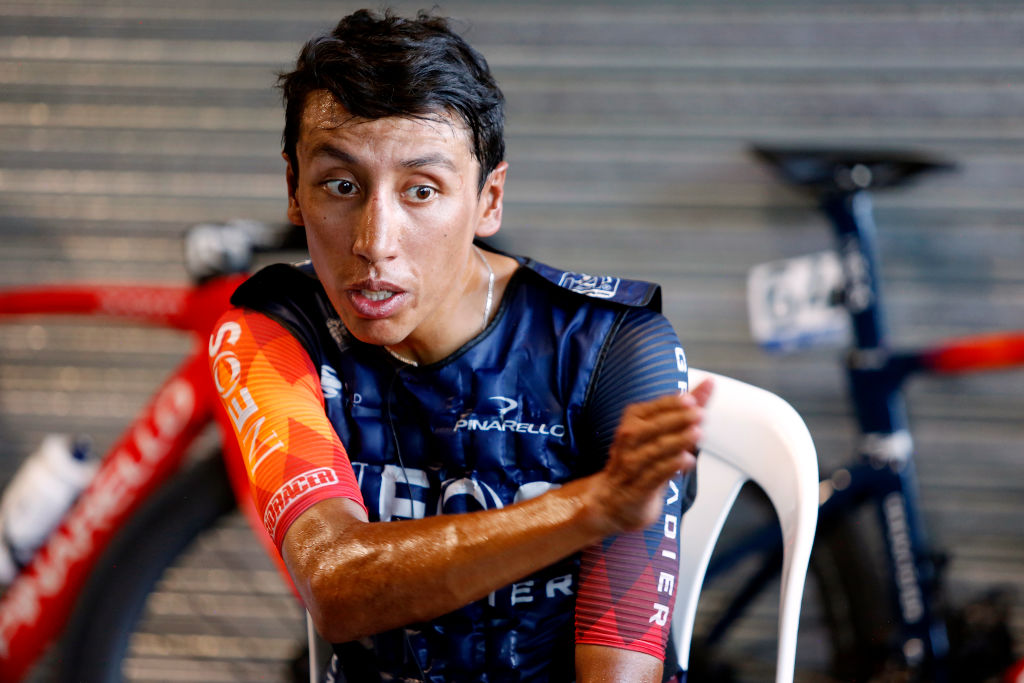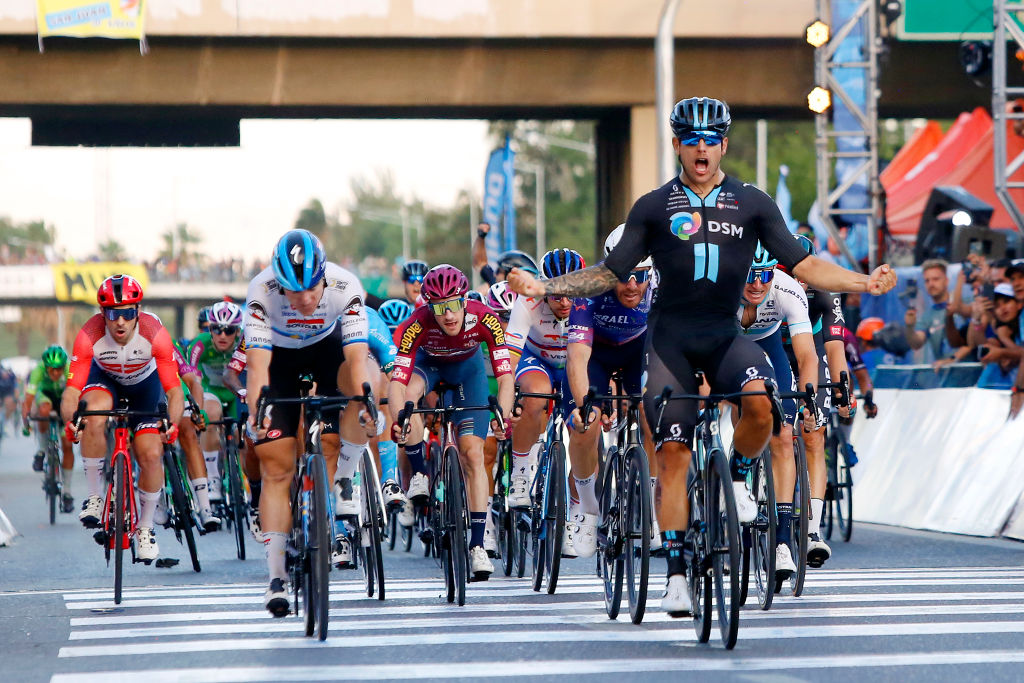Five conclusions from the 2023 Vuelta a San Juan
Evenepoel’s mistake, Bernal’s setback, López’s closed doors

Remco Evenepoel, Egan Bernal and Miguel Ángel López generated the headlines ahead of the Vuelta a San Juan and they continued to lead the billing throughout the week as the race made its return to the calendar after a two-year hiatus due to the coronavirus pandemic.
Although he was unable to emulate his 2020 victory, Evenepoel was still a factor on every stage, including an unexpected cameo in the closing circuit stage. Bernal marked the anniversary of his career-threatening crash with encouraging climbing displays in Argentina, only to leave the race with a knee injury. López, dismissed by Astana last month, claimed victory for his Medellín-EPM squad.
Elsewhere, Quinn Simmons won on stage 3 and caught the eye across the week, Peter Sagan outlined his intention to retire from WorldTour road racing at year’s end, and the race’s bunch sprints were of a quality rarely seen outside the Grand Tours.
Cyclingnews looks at five of the talking points from this year’s race.
López’s win unlikely to open WorldTour doors

An extended podium ceremony that incorporated a fireworks display meant darkness had long since fallen by the time Miguel Ángel López made his way to the press conference tent on the final evening of the Vuelta a San Juan.
His pyrotechnics on the summit finish at Alto Colorado on stage 5 had secured overall victory, and the Colombian’s hope is that his performance in Argentina will spark interest from WorldTour teams after his dismissal from Astana last month.
But is it really likely?
The latest race content, interviews, features, reviews and expert buying guides, direct to your inbox!
“Why not? You never know what could happen. The future is unwritten,” López said. “Two or three weeks ago, it all looked closed for me, but today I see it in a different way. It could all change at any moment.”
He must know that is a rather optimistic assessment. It was questions of probity rather than performance that saw López cut loose in the first place, after all. His dominance on the Alto Colorado secured the Vuelta a San Juan, but it does nothing to change perceptions of his credibility.
López was fired by Astana for his links to Dr Marcos Maynar, currently at the centre of a doping inquiry in Spain, and with no suitor forthcoming in the WorldTour, he dropped down to Continental level for 2023 with Medellín-EPM. The fact that Óscar Sevilla, banished from the top flight after Operación Puerto, is among his teammates is hardly an encouraging omen.
Were this twelve months ago, when WorldTour teams in the relegation zone were desperate for proven points-scorers, López might have found somebody willing to take a punt on services, despite the uncertainty over what might yet emerge from Spain.
But with the three-year relegation cycle beginning all over again in 2023, nobody is drinking at the last chance saloon, and López looks set to be left on the outside. The Vuelta a San Juan is likely to be as good as it gets.
A useful kind of mistake for Remco Evenepoel

On arriving at the Soudal-QuickStep tent atop Alto Colorado, Remco Evenepoel sat by himself, staring into the middle distance and silently stewing over his sin of presumption on the toughest climb of the race.
Within a few minutes, however, the world champion was on his feet and even smiling as he talked reporters through his error.
“I did a stupid move, because I went for one minute at full gas and then I tried to keep a high speed,” Evenepoel said. “But I was alone, so I should have stopped riding immediately.”
When Evenepoel accelerated from the leading group with 10.5km to go, it initially looked like the race-defining move, but his solo effort caught up with him three kilometres later and he had to relent. Unable to follow López’s winning attack shortly afterwards, he had to settle for seventh place at the summit, 1:09 down.
It wasn’t how Evenepoel envisaged finishing the day but he wore his disappointment lightly: “I was alone, so I should have stopped riding immediately.”
Evenepoel’s 2022 season will be remembered for his wins at Liège-Bastogne-Liège, the Vuelta a España and the World Championships, but it’s easy to overlook that significant defeats – and his response to them – were also an important part of the narrative. He suffered setbacks of varying degrees at the Volta a la Comunitat Valenciana, Tirreno-Adriatico, Itzulia Basque Country and the Tour de Suisse.
In Valencia, Evenepoel’s irritation at losing the yellow jersey was patently evident, written across his face even before he crossed the finish line. Yet by the time he reached Switzerland in June, he was altogether calmer in the face of defeat. It was as though Evenepoel, so often stronger than his mistakes, now realised that he could learn from them too. The lessons were applied forcefully at the Vuelta.
Evenepoel seemed to have that in mind when he gathered his thoughts atop the Alto Colorado. The first half of his season, after all, is all about building towards the Giro d’Italia.
“It’s better to make a mistake like that now than in the Giro,” he said. His next stop is the UAE Tour next month. He’s unlikely to repeat the same error there.
Hope mixed with frustration for Egan Bernal

Egan Bernal’s acceleration on the Gruta Virgen de Andacollo on stage 4 was his first time at the front of a bike race since before his horrific training crash of a year ago. The moment was largely unseen but did not go unnoticed.
A patchy live television feed meant that news of his attack travelled by word of mouth, relayed to the press room and beyond by observers in the race convoy. It was difficult to draw any firm conclusions about an act imagined rather than witnessed, but the news was heartening all the same.
The signs were more visible and even more encouraging on the Alto Colorado two days later, when Bernal was among the elite cadre of chasers behind the untouchable López. His fourth place finish at the summit, 40 seconds down on López but within sight of Sergio Higuita (Bora-Hansgrohe), seemed to bear out Bernal’s belief that his January form was in line with the years before his crash.
The Ineos rider’s aim of being “competitive” at the Tour de France suddenly felt a lot more feasible.
A day later, however, Bernal’s race took on a different tone when he stepped off his bike just 18km into stage 6.
Ineos soon explained that he had injured his left knee in a crash on the opening stage, with the pain exacerbated by his efforts on the Colorado. Mercifully, the pain was not in the right knee Bernal fractured last January, and the noises emanating from Ineos the following day were optimistic, namely that his abandon was a precaution more than a preoccupation.
Even so, it will surely have been a frustration for Bernal. A week that had augured so well ended with a reminder that the road back is never smooth.
Welsford the break-out sprint star in San Juan

When Sam Welsford caught his wheel on a cats eye and slid along the road on stage 2 of the Vuelta a San Juan, he must have regretted Team DSM’s decision to send him to Argentina rather than field him at the Tour Down Under. By week’s end, however, his selection for the Vuelta a San Juan seemed a master stroke, and, perhaps, a sign of things to come.
Although a ProSeries race, the Vuelta a San Juan’s course sufficed to attract a WorldTour-level cohort of sprinters to Argentina. Sam Bennett (Bora-Hansgrohe) and Fabio Jakobsen (Soudal-QuickStep) were the marquee names and they duly swapped stage wins on the opening two days, before Fernando Gaviria (Movistar), a man with as many hits to his name in Argentina as Soda Stereo, continued his remarkable sequence in these parts with victory from a reduced bunch on stage 4.
The grandees were expected to shine again on the flat, final weekend, but instead it was Welsford, aided by an unheralded but cohesive Team DSM lead-out, who scorched to two fine victories.
In the first, the slightly downhill finishing straight allowed Welsford to come from behind at the last to pip Bennett. He confirmed that was no accident with his second, careering off Giacomo Nizzolo’s wheel to take the win. Fabio Jakobsen was impeded by the outstretched arm of a spectator, but it’s not clear that the Dutchman was getting back on terms with the flying Welsford.
Although 27 years of age, Welsford is only in his second WorldTour season, having focused on his track career up until the Tokyo Olympics, meaning he ought to have considerable margin for improvement. He already caught the eye at Scheldeprijs last year, but Welsford’s displays in Argentina had the feel of a leap forward.
“Team DSM have had full belief that I could become one of the fastest sprinters in the world,” said Welsford, who will travel to the UAE Tour with ambition.
Ganna carries Hour Record momentum into 2023

A few seconds with his forearms resting in an apparently non-compliant position atop the Alto Colorado saw Filippo Ganna fined by the commissaires, but it didn't detract from the quality of his performance on the Vuelta a San Juan’s toughest stage.
Technically, Ganna could even have been disqualified once the offence was flagged, but given the fuzzy wording of the UCI rules, there were few complaints about the hazy application of sanctions.
As in 2020, Ganna finished the Vuelta a San Juan in second place overall, but his performance here was more impressive than his display of three years ago. With no time trial on this year’s route, Ganna’s podium finish was built first on his opportunistic attempt at surprising the sprinters in Barreal on stage 4 and then on his dogged pursuit of López on the Colorado.
Ineos had several options on the climb, notably Bernal, Brandon Rivera and Daníel Martínez, but Ganna proved the strongest. After leading the chase of Evenepoel’s long-range attack, he battled gamely to get back on terms with López, ultimately coming home second, only half a minute down.
The steady gradients of the Alto Colorado lend themselves perfectly to Ganna’s gifts as a rouleur, and he ran through the scales impressively on Friday.
His next appointment is at the European Track Championships in Grenchen in mid-February, but his first outing on the road augurs well for his targets further down the line, which include another tilt at Paris-Roubaix and a return to the Giro d'Italia.

Barry Ryan was Head of Features at Cyclingnews. He has covered professional cycling since 2010, reporting from the Tour de France, Giro d’Italia and events from Argentina to Japan. His writing has appeared in The Independent, Procycling and Cycling Plus. He is the author of The Ascent: Sean Kelly, Stephen Roche and the Rise of Irish Cycling’s Golden Generation, published by Gill Books.